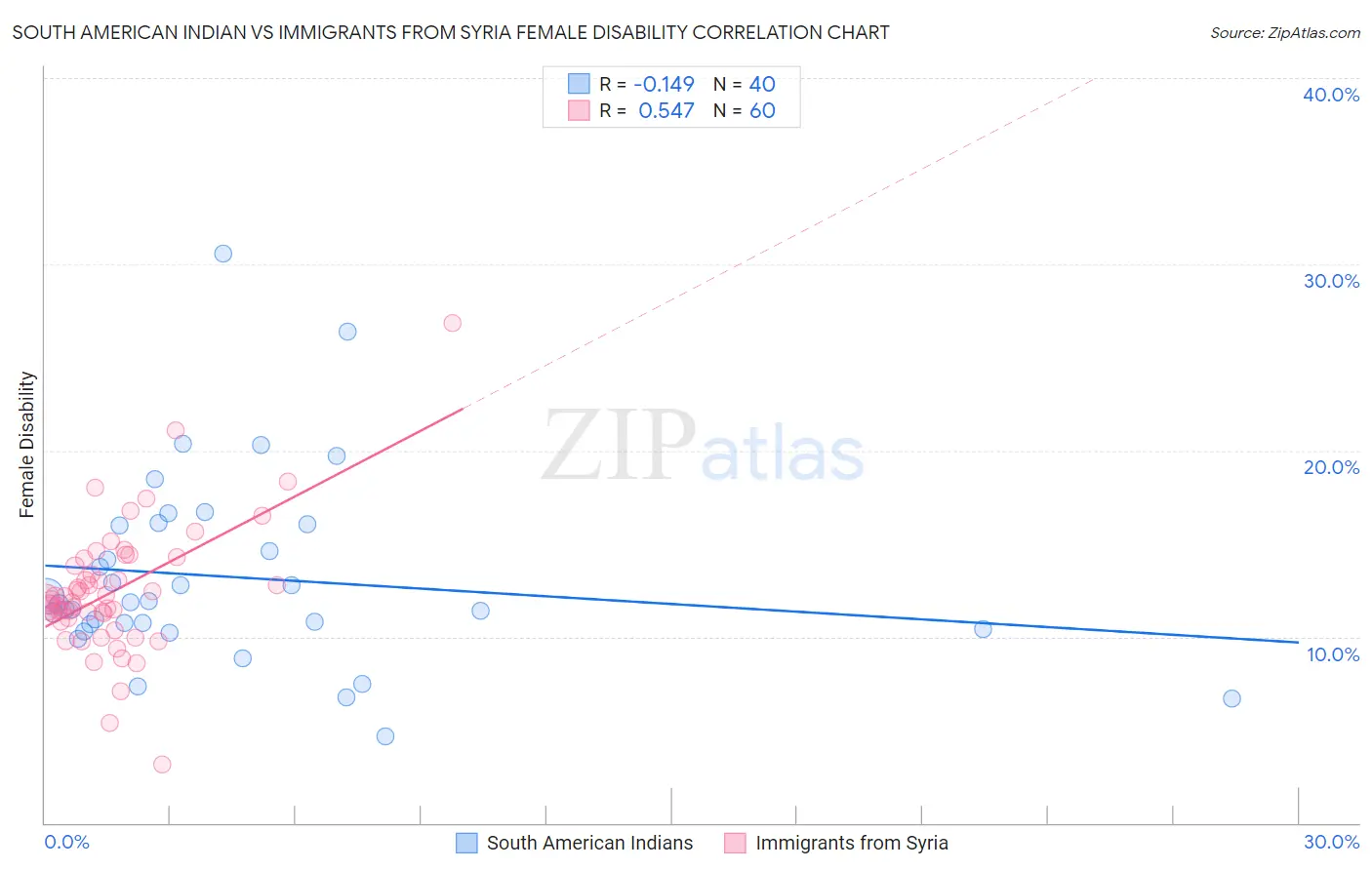South American Indian vs Immigrants from Syria Female Disability
COMPARE
South American Indian
Immigrants from Syria
Female Disability
Female Disability Comparison
South American Indians
Immigrants from Syria
11.8%
FEMALE DISABILITY
95.8/ 100
METRIC RATING
127th/ 347
METRIC RANK
11.9%
FEMALE DISABILITY
94.6/ 100
METRIC RATING
132nd/ 347
METRIC RANK
South American Indian vs Immigrants from Syria Female Disability Correlation Chart
The statistical analysis conducted on geographies consisting of 164,561,575 people shows a poor negative correlation between the proportion of South American Indians and percentage of females with a disability in the United States with a correlation coefficient (R) of -0.149 and weighted average of 11.8%. Similarly, the statistical analysis conducted on geographies consisting of 174,112,013 people shows a substantial positive correlation between the proportion of Immigrants from Syria and percentage of females with a disability in the United States with a correlation coefficient (R) of 0.547 and weighted average of 11.9%, a difference of 0.25%.

Female Disability Correlation Summary
| Measurement | South American Indian | Immigrants from Syria |
| Minimum | 4.7% | 3.1% |
| Maximum | 30.6% | 26.8% |
| Range | 25.9% | 23.7% |
| Mean | 13.2% | 12.5% |
| Median | 11.8% | 12.0% |
| Interquartile 25% (IQ1) | 10.5% | 11.1% |
| Interquartile 75% (IQ3) | 16.0% | 14.0% |
| Interquartile Range (IQR) | 5.5% | 2.9% |
| Standard Deviation (Sample) | 5.1% | 3.5% |
| Standard Deviation (Population) | 5.1% | 3.5% |
Demographics Similar to South American Indians and Immigrants from Syria by Female Disability
In terms of female disability, the demographic groups most similar to South American Indians are Immigrants from Latvia (11.8%, a difference of 0.040%), Macedonian (11.8%, a difference of 0.070%), Immigrants from Europe (11.8%, a difference of 0.10%), Nicaraguan (11.9%, a difference of 0.13%), and Arab (11.9%, a difference of 0.16%). Similarly, the demographic groups most similar to Immigrants from Syria are Kenyan (11.9%, a difference of 0.010%), Immigrants from Nicaragua (11.9%, a difference of 0.010%), Central American (11.9%, a difference of 0.080%), Arab (11.9%, a difference of 0.10%), and Ugandan (11.9%, a difference of 0.10%).
| Demographics | Rating | Rank | Female Disability |
| Immigrants | Uganda | 97.2 /100 | #119 | Exceptional 11.8% |
| Immigrants | Kazakhstan | 97.0 /100 | #120 | Exceptional 11.8% |
| Immigrants | Netherlands | 96.9 /100 | #121 | Exceptional 11.8% |
| Immigrants | North Macedonia | 96.8 /100 | #122 | Exceptional 11.8% |
| Immigrants | Croatia | 96.7 /100 | #123 | Exceptional 11.8% |
| Russians | 96.5 /100 | #124 | Exceptional 11.8% |
| Immigrants | Italy | 96.4 /100 | #125 | Exceptional 11.8% |
| Immigrants | Europe | 96.2 /100 | #126 | Exceptional 11.8% |
| South American Indians | 95.8 /100 | #127 | Exceptional 11.8% |
| Immigrants | Latvia | 95.6 /100 | #128 | Exceptional 11.8% |
| Macedonians | 95.5 /100 | #129 | Exceptional 11.8% |
| Nicaraguans | 95.2 /100 | #130 | Exceptional 11.9% |
| Arabs | 95.1 /100 | #131 | Exceptional 11.9% |
| Immigrants | Syria | 94.6 /100 | #132 | Exceptional 11.9% |
| Kenyans | 94.5 /100 | #133 | Exceptional 11.9% |
| Immigrants | Nicaragua | 94.5 /100 | #134 | Exceptional 11.9% |
| Central Americans | 94.2 /100 | #135 | Exceptional 11.9% |
| Ugandans | 94.0 /100 | #136 | Exceptional 11.9% |
| Immigrants | Norway | 93.8 /100 | #137 | Exceptional 11.9% |
| Ecuadorians | 93.4 /100 | #138 | Exceptional 11.9% |
| Immigrants | Hungary | 92.8 /100 | #139 | Exceptional 11.9% |